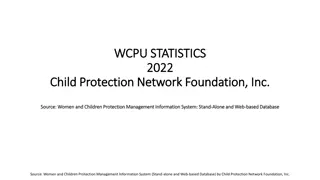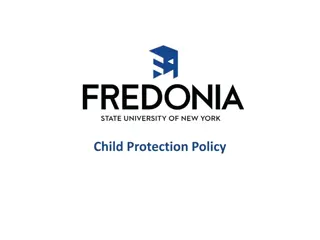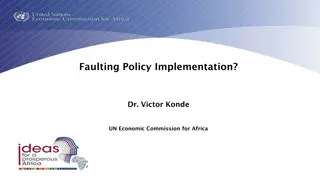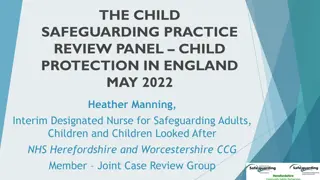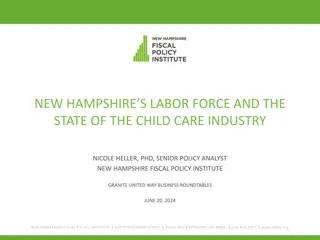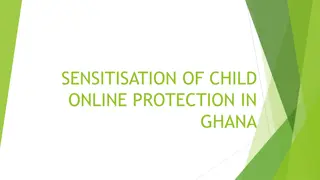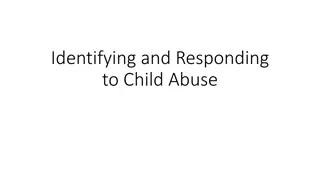Child Protection Policy and Procedure Implementation Overview
Explore the essential aspects of implementing child protection policies and procedures, including the definition of a child, the referral process, key statements, and correct practices to safeguard children from abuse. Learn about the roles of various professionals in child protection and understand the importance of respecting children's rights and dignity throughout the intervention process.
Download Presentation

Please find below an Image/Link to download the presentation.
The content on the website is provided AS IS for your information and personal use only. It may not be sold, licensed, or shared on other websites without obtaining consent from the author.If you encounter any issues during the download, it is possible that the publisher has removed the file from their server.
You are allowed to download the files provided on this website for personal or commercial use, subject to the condition that they are used lawfully. All files are the property of their respective owners.
The content on the website is provided AS IS for your information and personal use only. It may not be sold, licensed, or shared on other websites without obtaining consent from the author.
E N D
Presentation Transcript
Assess Review Plan Implement
POLICY PROCEDURE A policy is a course of action adopted and pursued by a government A series of steps taken to implement the policy Policies are the "rules" which govern the implementation of social services Procedures indicate what must or may be done in specified circumstances How we are going to do it What we want to do We want to protect children from harm We will use Case Management to assess and plan interventions
1. Who can make a referral to the child protection unit or Child Protection Officer? a. Social worker b. Doctor c. PNTL d. Lawyer e. Neighbour f. None of the above g. All of the above
2. In the policy and procedure document a child is defined as? a. under 18 years old b. under 18 years old unless they are married c. under 15 years old d. under 18 years old unless they are working
3. Which of the following statements is incorrect? a. Casework is based on respect for all individuals and safeguards their dignity and rights b. All children have equal rights to protection from abuse and exploitation c. Child abuse is sometimes acceptable d. We should always listen to and takes seriously the views and wishes of children
4. Which of the following statements is correct? a. Intake, assess, case plan, review b. Intake, case plan, review, assess c. Intake, case plan, monitor, case closure d. Case plan, assess, monitor, case closure
5. Which of the following statements is incorrect? a.Child abuse is a criminal offence b.Beating a child with a stick until he is bleeding is abuse c.Employing children is OK because it helps them and their families even if they do not go to school d.Yelling violently at a child repeatedly is emotional abuse
6. Fill in the missing words a. INTAKE is the process by which DNRS receives information about cases b. Assessment is a continuous process. It involves making JUDGEMENTS about the circumstances of the child c. Implementing a case plan should be well PLANNED d. A review is a comprehensive EVALUATION of the current circumstances
7. Which of the following have a responsibility for reporting and preventing child abuse? a. PNTL b. Teachers c. Doctors d. Grand Mothers e. Church Leaders f. None of the above g. All of the above
8. True of False. Case conferences are only necessary if there is going to be a criminal prosecution. 9. True or False. If parents don t want a case of child abuse to go to court the police can drop the case. 10. True or False. Case files are only needed if the case isn t resolved in the first two weeks.
Policy Procedure Guidance 1. Receive information 2. Assess situation 3. Write an intervention plan 4. Agree plan with client 5. Implement plan 6. Monitor intervention 7. Review plan 8. Revise plan 9. Agree with client 10.Implement plan 11.Review plan 12.Close case 1. Referrals can be accepted from any person with a concern about a child. This may include professionals from health and education of the PNTL as well as family members, neighbours or community members. On receipt of a referral you must find out and record as much information as possible including the persons details as well as details of their concerns. We promise to plan all interventions with vulnerable clients to make sure they receive the most effective services
Children shall be entitled to special protection by the family, the community and the State, particularly against all forms of abandonment, discrimination, violence, oppression, sexual abuse and exploitation. Section 18:1, Constitution of the Democratic Republic of Timor-Leste State Parties shall take all appropriate measures to protect the child from all forms of physical or mental violence, injury or abuse, neglect or negligent treatment, maltreatment or exploitation, including sexual abuse while in the care of legal guardian(s) or any other person who has the care of the child. Article 19 UNCRC
The Organic Law of the Ministry of Social Solidarity No. 23. 23 January 2008 requires DNRS to develop and implement policy and programmes in defense of the rights of children (Article 11, Section 2(d).)
CHILD PROTECTION POLICY child abuse is a violation of children's rights and is never acceptable we all have a responsibility to protect children from harm and our behaviour should reflect this partners also have a responsibility to meet minimum standards of protection for children in their programmes sanctions will be imposed on any person or organisation who breaches the Policy
Policy Commitment Monitoring Evidence Framework for Training Child Protection Training Modules Personnel Files Evaluation Sheets Staff Consultation Provide learning opportunities for staff to develop and maintain the necessary attitudes, skills and knowledge to keep children safe, ensuring all staff receive child protection training as part of their induction Provide written guidelines which describe what is appropriate behaviour in all our contacts with children Child Protection Policy and Code of Conduct Staff Consultation Child Protection Training Modules
Legal and Procedural Framework Constitution of Timor Leste UNCRC Organic Law of Ministry of Social Solidarity Child Protection Policy Policy and Procedure for Case Management in Child Protection Policy and Procedures for Child Care Centres and Boarding Houses Policy and Guidelines for Unaccompanied and Separated Children
Assess What is the problem? Review Is the problem solved? Plan What are the possible solutions? Implement Try out the proposed solutions?
Information received about alleged child abuse 1. Complete Intake and Allocation Form 2. Conduct initial screening within 48 hours. 3. Agree decision with supervisor in writing Decision: Decision: Decision: No further action Complete Assessment within 7 days and make recommendations Emergency action to prevent child from further harm Initial Case Conference (within 14 days) Close Case Case Plan: set goals, agree actions & timescales & responsible people Implement Case Plan: maintain routine written record Review Case Conference (maximum 6 months)
CHILDREN 1ST
ACTIVITY PLANNER SPREADSHEET Month 1 Month 2 Month 3 Week Week Week Week Week Week Week Week Week Week Week Week Week ACTIVITY By whom No. 1 2 3 4 1 2 3 4 5 1 2 3 4
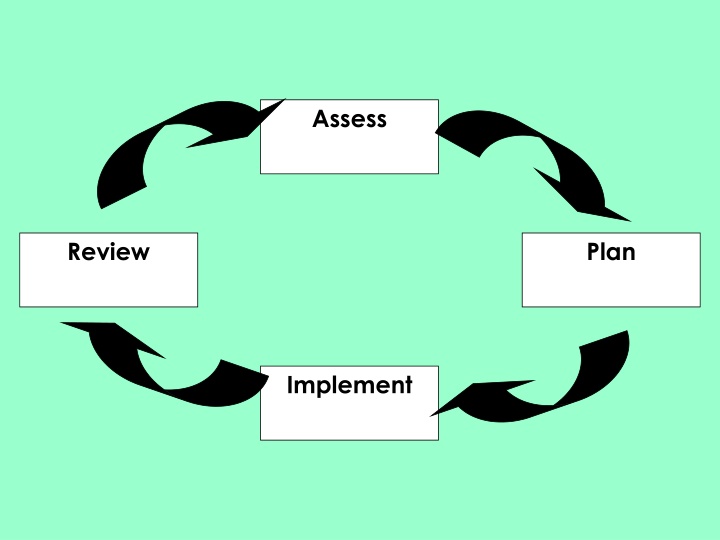


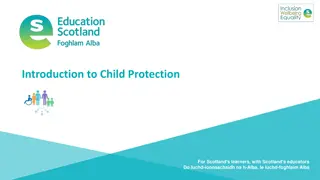
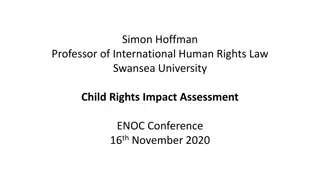
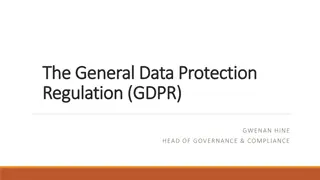

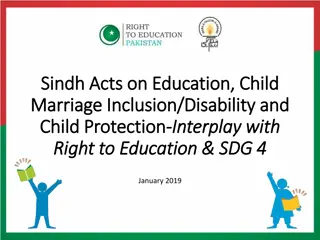
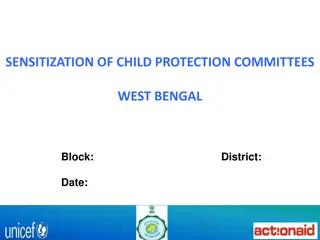

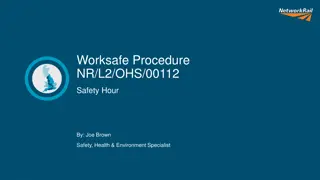

![Briefing on the Criminal Procedure Amendment Bill [B12-2021] to the Portfolio Committee on Justice and Correctional Services](/thumb/157093/briefing-on-the-criminal-procedure-amendment-bill-b12-2021-to-the-portfolio-committee-on-justice-and-correctional-services.jpg)

